Japan
Wood Products Prices
Dollar Exchange Rates of 25th
September
2018
Japan Yen 112.78
Reports From Japan
¡¡
An alternative view on
prospects for growth in Japan
The almost universal negative view of prospects for the
Japanese economy has been challenged in a recent article
written by Adair Turner and published by Project-
Syndicate.
Adair Turner, a former chairman of the United Kingdom's
Financial Services Authority and former member of the
UK's Financial Policy Committee, is Chairman of the
Institute for New Economic Thinking.
The article points out that years of zero interest rates and
massive quantitative easing have failed to achieve the 2%
inflation target the Bank of Japan set itself. On top of this
a rapidly aging and declining population and an aversion
to immigration means that Japan¡¯s workforce could drop
by almost a third by 2070.
The signs are not good says the author, pointing out that
since 1991 economic growth has been below 1% which,
when combined with other factors, has driven government
debt to over 200% of GDP.
Conventional thinking is that tax increases and reduced
public spending must be introduced to drive down the
deficit and avoid a debt crisis. But is there another view?
Turner writes¡± While Japan¡¯s demographic decline poses
challenges, it may also imply some advantages: and
Japan¡¯s debts are far more sustainable than they appear.
True, Japan¡¯s GDP growth lags most other developed
economies, and will likely continue to do so as the
population slowly declines.
But what matters for human welfare is GDP per capita,
and on this front Japan¡¯s 0.65% annual growth in the
decade since 2007 equals the US and is better than the
UK¡¯s 0.39% and France¡¯s 0.34% ¨C not bad for a country
starting with one of the world¡¯s highest living standards¡±.
For more see: https://www.projectsyndicate.
org/commentary/japan-successful-economic-model-byadair-
turner-2018-09

BoJ signals determination to stay the course
to
achieve inflation target
At its mid-September policy meeting the Bank of
Japan (BoJ) did not change its stance on monetary policy
and maintained its optimistic view on the economy despite
the risks to the global economy from trade frictions.
Short term interest rates were kept at minus 0.1% and the
BoJ pledged to keep interest rates extremely low for an
extended period.
Because inflation has not taken hold the BoJ introduced
new measures signaling its determination to stay the
course and active its 2% inflation target.
Yen moves close to low seen in January
In a recent speech the Bank of Japan Governor reaffirmed
that the Bank is confident the Japanese economy will
continue to expanding with expectations of annualised
growth of 3.0% likely in the third quarter. But, the Bank is
still struggling to achieve its 2% inflation target as
consumer prices remain subdued.
External issues exerted pressure on the yen in late
September and the yen touched 113 to the dollar, a low not
seen since January this year.
The strong dollar, together with a rally in US equities, is
setting the tone of the market at present. Also holding the
US dollar at its high is the message from China that, while
pressure from the US will not undermine the Chinese
economy, it is open to negotiations to resolve the trade
dispute.
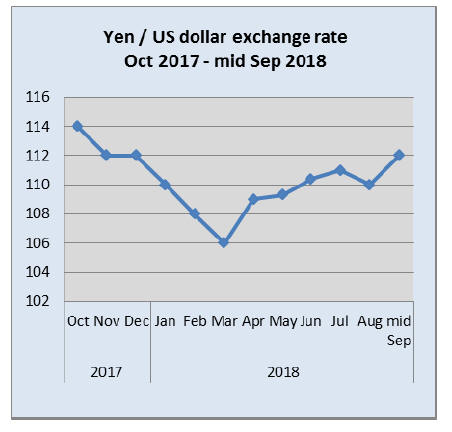
August orders for new homes reverse fall in
July
Data from Ministry of Land, Infrastructure, Transport and
Tourism on August housing starts show a year on year
increase for the first time in two months Housing starts
increased a modest 1.5%percent in August compared to
levels in August last year.
Data from the ministry also show that orders received by
the top 50 builders rose 0.5 slightly in August contrasting
with the sharp fall in July. Orders for new homes increased
for the first time in four months.
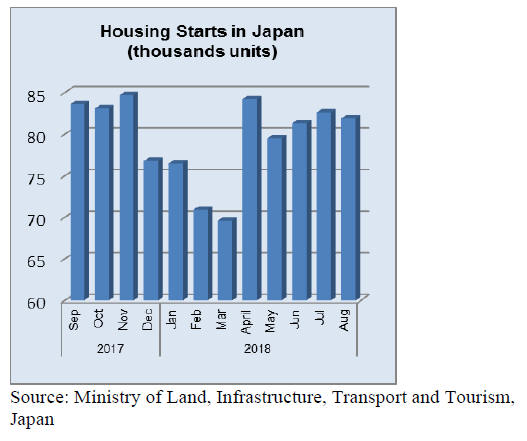
Import round up
Doors
July door imports
After the peak in May imports, the value June and July
imports of wooden doors (HS441820) declined. Year on
year, July wooden door imports were down slightly but
month on month there was little change.
Most wooden door imports are from China (63%)
followed by the Philippines (19%) and Malaysia (8%).
These three suppliers accounted for around 90% of
Japan¡¯s July wooden door imports
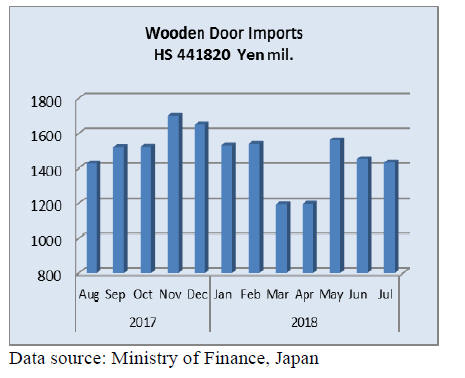
Window imports
July window imports
Japan¡¯s monthly imports of wooden windows (HS
441810) have remained at around the same level since a
peak in March. Year on year, July imports fell sharply,
dropping 26% but month on month the value of imports
remained unchanged.
Two suppliers, China and the US account for over 60% of
Japan¡¯s imports of wooden windows with another 20%
coming from the Philippines. In July the US topped the
list of suppliers.
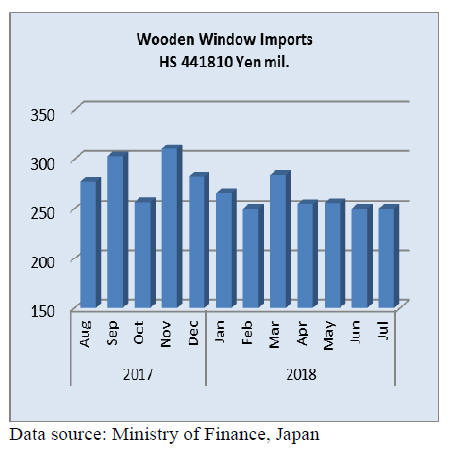
Assembled flooring
July flooring imports
Japan¡¯s imports of wooden flooring continue to be
dominated by HS441875 followed by HS441879. In July,
as in the previous month these two categories of
assembled flooring accounted for around 90% of the value
of all assembled wooden flooring imports.
The main shippers of HS441875 in July were China
(66%), Vietnam (8.5%) and Thailand (8.5%). In contrast
for HS441879 the main shippers in July were Thailand
(43%) and Indonesia also (43%).
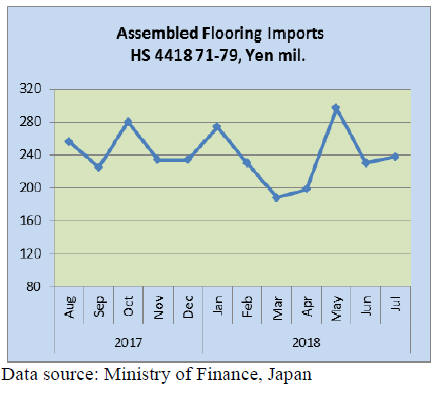
Plywood
July plywood imports
For two consecutive months there has been a sharp decline
in Japan¡¯s imports of plywood (HS441210-39). Year on
year the volume of imports has fallen 5% and in July there
was a 9% month on month fall.
The biggest decline was in imports from Malaysia which
dropped over 20% year on year. In contrast, the volume of
imports from both Indonesia and China rose (5% and 40%
respectively).
Imports of HS441231 dominte Japan¡¯s plywood imports
accounting for over 85% of imports with Malaysia and
Indonesia being the main shippers. In July a small volume
of HS441231 arrived from Vietnam.
For both HS441233 and HS441234 Malaysia is the main
shipper with China and Vietnam contributing small
volumes to July imports.
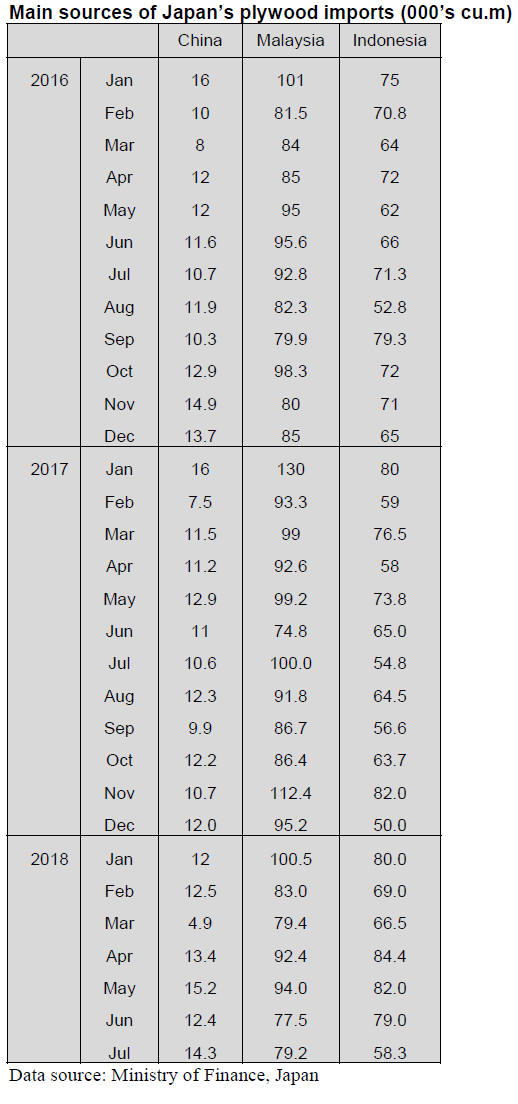 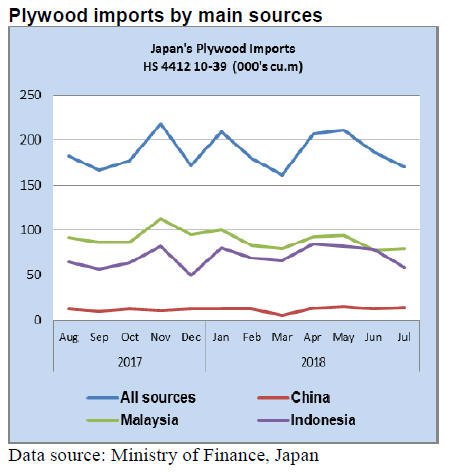
Trade news from the Japan Lumber Reports (JLR)
For the JLR report please see:
http://www.n-mokuzai.com/modules/general/index.php?id=7
Plywood supply
Total plywood supply in June was 514,100 cbms, 3.7%
more than June last year and 4.6% less than May. While
domestic softwood plywood production was over 250,000
cbms, imported plywood supply did not increase much.
Total domestic plywood supply was 281,800 cbms, 1.4%
more and 7.3% more. In this, softwood plywood was
271,900 cbms, 2.4% more and 8.0% more out of which
non-structural plywood production was 18,700 cbms,
56.0% more and 8.3% more. The shipment of domestic
plywood was 262,300 cbms, 5.3% less and 3.8% more.
This is three consecutive months¡¯ high level shipment over
250,000 cbms.
In this, softwood plywood was 249,700 cbms, 5.1% less
and 3.8% more. The inventories at the end of June were
148,900 cbms. The inventories have been increasing for
five straight months but they are less than one month
consumption.
Volume of imported plywood in June was 232,200 cbms,
6.7% more and 15.8% less. The volume varies by the
month but an average monthly volume of imported
plywood for the first six months was 247,800 cbms, 0.1%
more than the same period of last year. By source, 79,700
cbms from Malaysia, 3.7% more and 17.7% less, 85,600
cbms from Indonesia, 15.9% more and 5.8% less, 46,600
cbms from China, 11.5% less and 29.4% less.
Malaysian volume dropped less than 80,000 cbms after
one year while Indonesian supply exceeded 80,000 cbms
for two straight months. The volume for the first six
months of this year shows the same trend of declining
Malaysian and increasing Indonesian. By thickness, thin
hardwood plywood of 3 mm or less increased by 29.5%
with 78,600 cbms.
Plywood
Movement of plywood of both domestic and imports in
August was stagnating. The prices are on weak side and
there some low priced offers in the market but domestic
manufacturers and importers are rigidly holding the prices
so there are no extreme low prices in the market. The
manufacturers are in no hurry to ship out with low prices
as they need to hold certain amount of inventories with
shortage of trucks.
Imported plywood movement is fairly well but there is no
robustness. Softwood plywood production in July was
267,700 cbms, 2.3% more than July last year and 1.5%
less than June.
The shipment of softwood plywood was 259,400 cbms,
1.0% less and 3.9% more. The manufacturers¡¯ shipment
continues same as last year despite dullness in the market.
The inventories of softwood plywood were 173,300 cbms,
9,800 cbms more than June end. The inventories have
been increasing month after month but they are only 0.6
month.
On imported plywood, arrivals of high cost cargoes have
started and the importers try to push the sales prices little
by little. It is hard to increase the sales prices but bottom
level is firm now. Dealers are watching softening of the
prices as the importers and large wholesalers may dispose
of the inventories since September is interim book closing
month.
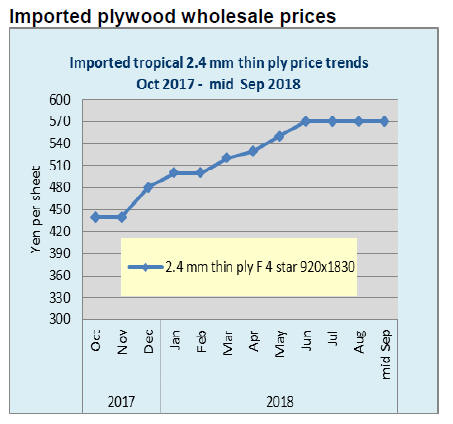 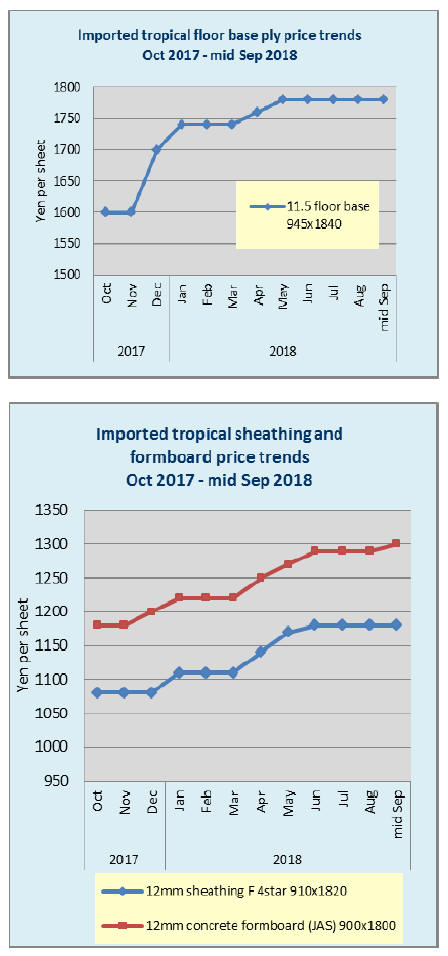
Vietnamese plywood prices rising
Export prices for Vietnamese eucalyptus plywood for
crating have been gradually climbing. Reason is heavy
rain damaged some veneer plants so that supply of veneer
is decreasing and the prices of veneer are escalating. This
results in higher cost of plywood so the export prices are
now more than US$320 per cbm C&F.
Some manufacturers shift to more profitable US market so
the supply for Japan is getting tight. By shortage of
veneer, shipments of contracted volume are delaying.
While export prices are climbing, the yen is getting
weaker so arrived yen cost is higher.
The market prices in Japan need to be revised higher to
cover the cost but the market in July was inactive and
August is vacation month so recovery would be in
September.
Demand is firm and there are some orders of non-JAS
plywood used for engineering works for restoration of
flood damaged Hiroshima and Okayama area.
First JIS MDF plant in Vietnam
MDF plant was built jointly by Korea¡¯s Dongwha
Enterprise and Vietnam Rubber Group in 2008. This is
VRG Dongwha Joint Stock Company with annual
production capacity of 558,000 cbms. This is the largest
MDF plant in Asia and it has acquired JIS certificate in
last July and will ship out first cargo for Japan in August.
The plant has one press for thick MDF of monthly
production of 31,500 cbms and one press for thin MDF of
monthly production of 15,000 cbms. For Japan market,
trial product is 2.5 mm thick 4x6.
Raw materials are rubber wood, acacia, Vietnamese pine
and cashew nut. For Japan market, the raw materials is
pine for thin MDF and acacia or pine for thick MDF.
In Vietnam, demand for furniture for U.S. market is active
so the plant is manufacturing furniture materials with U.S.
standard, which takes about 70% of market. It also exports
the products to the South Eastern Asian countries, India
and Middle East.
|